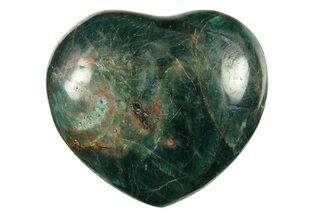This Specimen has been sold.
4.1" Apatite Crystals in Feldspar - Morocco
This specimen contains several beautiful, greenish-yellow apatite crystal that formed from a feldspar aggregate. This aggregation also contains calcite crystals, throughout. This crystal cluster was collected from Imilchil, Morocco.
It comes with an acrylic display stand.
#{feldspar}
It comes with an acrylic display stand.
About Apatite
Apatite is the name given to a generic group of isomorphous hexagonal phosphate minerals. Its name comes from the Greek word apatite, which means 'to deceive': this is because apatite often resembles other common hexagonal-habit minerals. Their bright, lustrous crystals are often found in vugs (small cavities in rock) associated with quartz and calcite. Many crystals are around an inch in length, though larger crystals up to about 4 inches long have been found.
Apatite is the name given to a generic group of isomorphous hexagonal phosphate minerals. Its name comes from the Greek word apatite, which means 'to deceive': this is because apatite often resembles other common hexagonal-habit minerals. Their bright, lustrous crystals are often found in vugs (small cavities in rock) associated with quartz and calcite. Many crystals are around an inch in length, though larger crystals up to about 4 inches long have been found.
#{feldspar}
About Calcite Crystals
Calcite crystals are a form of calcium carbonate (CaCO₃) known for their diverse shapes, transparency, and vibrant range of colors. They typically form in rhombohedral, scalenohedral, or prismatic shapes, often with well-defined, sharp edges and glossy surfaces. Calcite crystals are often translucent or transparent, sometimes displaying a double refraction effect where objects viewed through the crystal appear doubled. They can appear in various colors—white, clear, yellow, pink, blue, green, and orange—depending on impurities or trace minerals.
A notable characteristic of calcite is its reaction with weak acids like vinegar, which causes it to effervesce, or fizz, as it releases carbon dioxide. This property makes calcite crystals a key tool in geological identification and studies. Calcite forms in many environments, from sedimentary rocks like limestone and marble to hydrothermal veins.
Calcite crystals are a form of calcium carbonate (CaCO₃) known for their diverse shapes, transparency, and vibrant range of colors. They typically form in rhombohedral, scalenohedral, or prismatic shapes, often with well-defined, sharp edges and glossy surfaces. Calcite crystals are often translucent or transparent, sometimes displaying a double refraction effect where objects viewed through the crystal appear doubled. They can appear in various colors—white, clear, yellow, pink, blue, green, and orange—depending on impurities or trace minerals.
A notable characteristic of calcite is its reaction with weak acids like vinegar, which causes it to effervesce, or fizz, as it releases carbon dioxide. This property makes calcite crystals a key tool in geological identification and studies. Calcite forms in many environments, from sedimentary rocks like limestone and marble to hydrothermal veins.
SPECIES
Apatite, Calcite & Feldspar
LOCATION
Imilchil, Er Rachidia Province, Morocco
SIZE
Cluster is 4.1"x3.2"
CATEGORY
ITEM
#84329
 Reviews
Reviews














